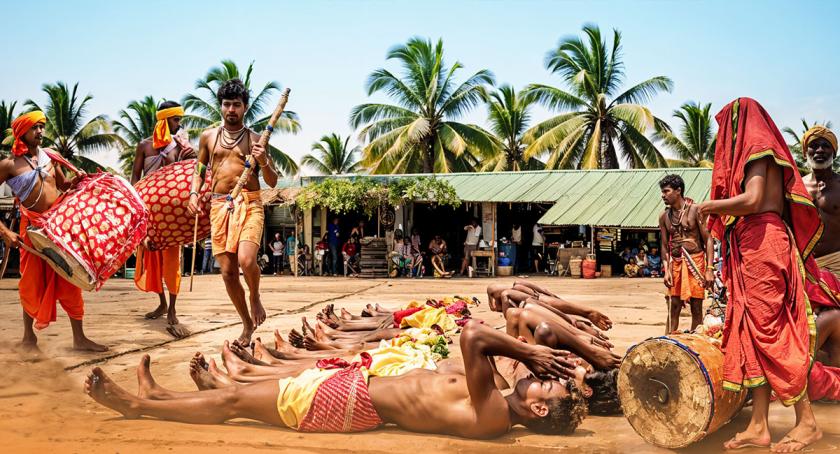The Mystical Danda Nata
Imagine a festival where devotees walk on fire, pierce their bodies, and perform incredible feats of perseverance—all in the name of faith and devotion. Welcome to Danda Nata, one of Odisha, India’s most intense and awe-inspiring rituals. This centuries-old festival is evidence of unwavering belief, rigorous discipline, and deep spiritual connection. Rooted in ancient traditions, Danda Nata is a display of endurance and a sacred journey toward purification and divine blessings.
The Story Behind Danda Nata
Danda Nata, or Danda Jatra, is an ancient folk festival primarily observed in Odisha’s Ganjam and Kandhamal districts. Its origins date back to the early medieval period, and it is strongly associated with Lord Shiva and Goddess Kali. Danda translates to “penance” or “punishment,” symbolizing the rigorous austerities performed by devotees. People think the celebration is a kind of Tantric devotion in which followers, called Bhaktas or Danduas, suffer greatly mentally and physically to obtain divine favors.
This sacred observance has been passed down through generations, maintaining its authenticity and spiritual significance. Unlike conventional religious celebrations, Danda Nata is performed with intense discipline, focusing on self-sacrifice, devotion, and the purification of mind, body, and soul.
When and How is Danda Nata Celebrated?
Danda Nata is observed during the Chaitra month of the Hindu calendar (March–April) and lasts between 13 and 21 days. The most spectacular performances occur over the festival’s final three days, drawing sizable crowds from all over the area. The ultimate tests of faith and endurance occur during this period, captivating spectators and devotees alike.
The festival unfolds in two main phases:
- Pani Danda (Water Rituals)
Devotees undergo purification rituals, take vows, and immerse themselves in water bodies as an act of spiritual cleansing. This symbolizes rebirth and prepares them for the challenges ahead.
- Agni Danda (Fire Rituals)
This is the most intense phase, during which participants perform endurance acts like walking on burning embers and lying on thorns. These rituals are a way to burn away past sins and attain divine blessings.
Throughout the festival, devotees practice strict discipline, following a code of conduct that includes fasting, celibacy, and meditation.
The Danduas: Devotees of Supreme Dedication
The participants, or Danduas, live a life of extreme discipline throughout the festival. They adhere to strict celibacy, sleep on the ground, eat simple vegetarian food, and wear saffron robes. Each devotee carries a wooden stick (Danda), symbolizing penance and spiritual strength.
A typical day for a Dandua involves:
- Waking up before dawn
- Offering prayers and performing yoga
- Walking barefoot over long distances
- Practicing severe self-mortification rituals
This intense discipline purifies the soul and strengthens one’s spiritual resolve. For the Danduas, every act performed during the festival is a sacred offering to the divine.
Awe-Inspiring Rituals of Danda Nata
Danda Nata is famous for its visually striking and extreme physical performances, showcasing the immense strength and faith of the devotees. Some of the most mesmerizing rituals include:
Walking on Fire (Agnidanda)
One of the most anticipated parts of Danda Nata is the devotees walking barefoot on a bed of flaming embers. The audience is left in wonder when they witness Danduas stepping over flames with assurance and without showing any signs of pain.
Body Piercing (Bana Danda)
In this ritual, Danduas use sharp metal tools, such as hooks and spears, to puncture their bodies as part of this ceremony to show their unwavering loyalty and suffering endurance. This deed represents the transcending of bodily suffering through spiritual power and self-sacrifice.
Water Rituals (Pani Danda)
Participants immerse themselves in water for extended periods while chanting hymns and prayers. This ritual represents purification and renewal, signifying the devotee’s spiritual rebirth.
Dramatic Dance Performances
Danda Nata is renowned for its vibrant folk dance performances and endurance exploits. In these shows, performers act out mythological stories, especially those involving Lord Shiva and Goddess Kali. These energetic and dramatic acts give the festival a cultural and artistic component.
Hanging from Hooks (Kaanta Danda)
In this jaw-dropping ritual, some devotees suspend themselves from metal hooks attached to their skin and swing in the air, showcasing ultimate spiritual surrender. People consider this the highest form of dedication, seeing the pain endured as an offering to the divine.
The Spiritual Significance of Danda Nata
Danda Nata is more than just a festival; it is a profound spiritual journey of self-purification and realization. The festival embodies:
- Devotion and Surrender: Participants dedicate themselves entirely to the service of the divine.
- Purification of Body and Soul: People believe extreme physical trials cleanse sins and bring spiritual awakening.
- Community Bonding: The festival fosters unity among participants and spectators, creating a powerful collective energy.
Participating in Danda Nata is a life-changing experience for many devotees, strengthening their faith and reinforcing their spiritual beliefs.
Where to Witness Danda Nata
If you wish to witness this extraordinary festival, head to the Ganjam, Kandhamal, or Berhampur districts of Odisha in March or April. The streets come alive with processions, music, and an electrifying spiritual atmosphere. The Danduas’ dedication and the crowds’ energy make this an unforgettable experience.
A Celebration Beyond Religion
Danda Nata is a festival of extraordinary resilience, devotion, and faith. Whether you’re a spiritual seeker, a cultural enthusiast, or an intrigued traveler, witnessing this festival will leave you in awe of human endurance and religious passion.


